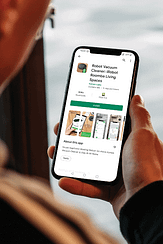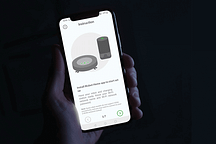Resources
A Brief Guide to the Internet of Things

We’re big fans of smart products in the right situations.
The internet of things industry is huge: in our last blog, we said that it’s projected to grow to 50 billion units by the end of 2030, and to expand even more as the idea of a completely connected house grows. We’re looking at a future where everything can be connected to an app on your smartphone, manipulated with one thumb, and made to work seamlessly with other smart devices.
That’s the ideal scenario.
In reality, it’s a little bit like the West Coast/East Coast argument: both sides have valid points, but whether or not you agree or not tends to be determined by what side you come from.
No matter which side you’re on, though, everyone admits that the Internet of Things is capable of some interesting product combinations. It can make your life easier and better and far more enjoyable. And some of the stuff we see has really interesting applications for real life, so we like to see industries looking at the internet of things and coming up with combinations that might not work for everyone, but can definitely work beautifully for a few people.
Why should you use IoT devices?
The Internet of Things is all about accessibility.
And a little bit about doing things that no other company has done just because you can.
Mostly, it’s about making life easier for the people who need it, whoever that may be: the overworked single mom, the family dad of four, the person who lives alone and doesn’t have time to do every single task on their to-do list.
Our rule of thumb is that any device or technology that makes life easier is a technology worth having.
Are IoT devices risky?
IoT devices don’t have the same cybersecurity threats as other internet-connected devices, but they are a target for hackers, and the technology is still so new that there’s only so much safer they can be. There’s also the concern over privacy: IoT devices are monitoring devices, and that information is stored in a cloud database. If you get hacked or you’re at risk of a cybersecurity breach, that data is vulnerable.
Furthermore, most IoT devices are location-based, and it’s not ideal to have your location online for everyone to see.
That said, the technology is changing, and it’s changing rapidly, and one of the core focuses for IoT improvements is security.
Should I make my product part of the IoT network?
That depends on you, the product you want to connect to an IoT network, and the audience you want to reach. Remember that the IoT industry is already saturated with devices, and while this absolutely doesn’t mean that you can’t have more in that same industry, you’ll need something to stand out from the rest of the internet of things crowd. So look at your product, talk to software developers, and understand whether or not connecting it to the internet is what’s best in this situation.
A lot of products can, and will, work with the internet. A lot of products can, and will, be internet-enabled, probably by the time we’ve finished this sentence.
However, it’s important to keep in mind that it should serve a purpose other than being connected to the internet just because every other product is.
Is there anything I should keep in mind when it comes to making smart products?
We like to think that all tech has a purpose for good in the world, so our advice is always to lean on the side of solving a problem or fixing a situation. It doesn’t have to fit everyone’s needs, and it doesn’t have to be a must-have product; it just has to fix an existing issue, and to make life easier for people.
With the Internet of Things especially, it’s easy to just think of the possibilities and not think of the real-world applications of smart products, or how they can best service a group of people or an industry. Just like forgetting about spring break until you walk outside to revellers on the beach, getting caught up in what you can do can eclipse what might be the real, fundamental aspect to work on, or what can really help whoever you’re making the product for – and you’ll already have an idea of who you’re making that product for.
It’s important not to lose that view while you’re working. That guiding principle is going to help you out a lot when you’re designing a product that can be smart-enabled.
Unusual IoT Devices To Look At
There’s an internet-enabled device in every industry you look at.
Here’s a few of our favourites, and what we think about them.
LavvieBot
This is the cat litter tray for the 22nd century: an automated cat litter tray that sends you a notification every time your cat uses it – and it self-cleans almost immediately. It’s space-efficient, quiet, and it monitors the litter box usage for your cat, meaning that you probably will end up knowing more about your pet than you really wanted to.
The good: it’s always ideal to monitor your cat’s habits, and as the website says, having a self-cleaning litter box can limit the cat’s distress, and free up some extra time in your schedule.
The bad: it might distress the cat more, and if you’re struggling to monitor a regular litter box, an IoT litter box is probably not going to make such a big difference to your schedule that you would absolutely need it.
Pro 575 Grill
What if you could control your grill from anywhere, and down to the precise temperature? The Pro 575 Grill uses its patented WiFire technology to update the barbecue into a grill that allows you to cook from anywhere, without lifting the lid, or the long waiting time it takes to get the grill going in the first place. It speeds up cleaning, it works on pellets, and it comes with a database of over 1,600 recipes to try out through their app.
The good: if you’re a grilling enthusiast who really wants to excel in what they do, but don’t have the time and the money to invest in trial and error, or don’t really want to invest in learning, this is a good balance. You can have your perfectly-barbecued meat, and eat it, too, without staying at the grill for every second of cooking time and risk ruining everything by opening the lid too early.
The bad: IoT security isn’t terrible, but the risk of having the grill hacked is an ever-present thought.

Smart Nora
You’re probably not going to notice if you snore, but whoever shares a room with you definitely will. The Nora is there to fix this problem with a custom-built pad underneath your pillow that connects to a monitoring device on your bedside table. When you start snoring, it’ll move your head to open your airways and stop you.
The good: people who have tried every other anti-snoring solution might really benefit from a computer that just nudges you over without the need to wake up whoever shares a room with you.
The bad: it’s unlikely that you would need smart snoring monitoring technology in the first place.
Aidia System
If you’ve ever had to take medication on time, you’ll know what a struggle it is to actually stick to those guidelines – and that’s just for when you’re sick. For people living with chronic conditions, a missed dose is going to be a bigger problem than just taking slightly longer to get over the flu, and that’s what the Aidia system wants to fix.
Aidia is a smart pill bottle that automatically reminds you to take your medication and can coordinate with your pharmacy and care support to help you through any health issues that can crop up.
The good: it’s one of the projects that we like to see the most of: the kind where there’s so much good that can come out of it. Forgetting your pills is a real concern that a lot of people with chronic conditions deal with, and it’s excellent to see that the tech world has something that can support them and push them forward.
The bad: nothing! This is one of those internet of things projects that deserves all the awards.

Conclusion
There’s no good or bad in technology. Ultimately, technology is just a tool, and a way of reaching a goal. What matters is the kind of technology you make: the purposes that you put into it, and what, and who, you want it to support.
When it comes to any smart product, we like thinking of who it can help. As a guiding principle, helping people is what tech should be about – so if you have a product that can really help people out, and you want to know if it should be smart, talk to us.
We’ll help you figure it out.



